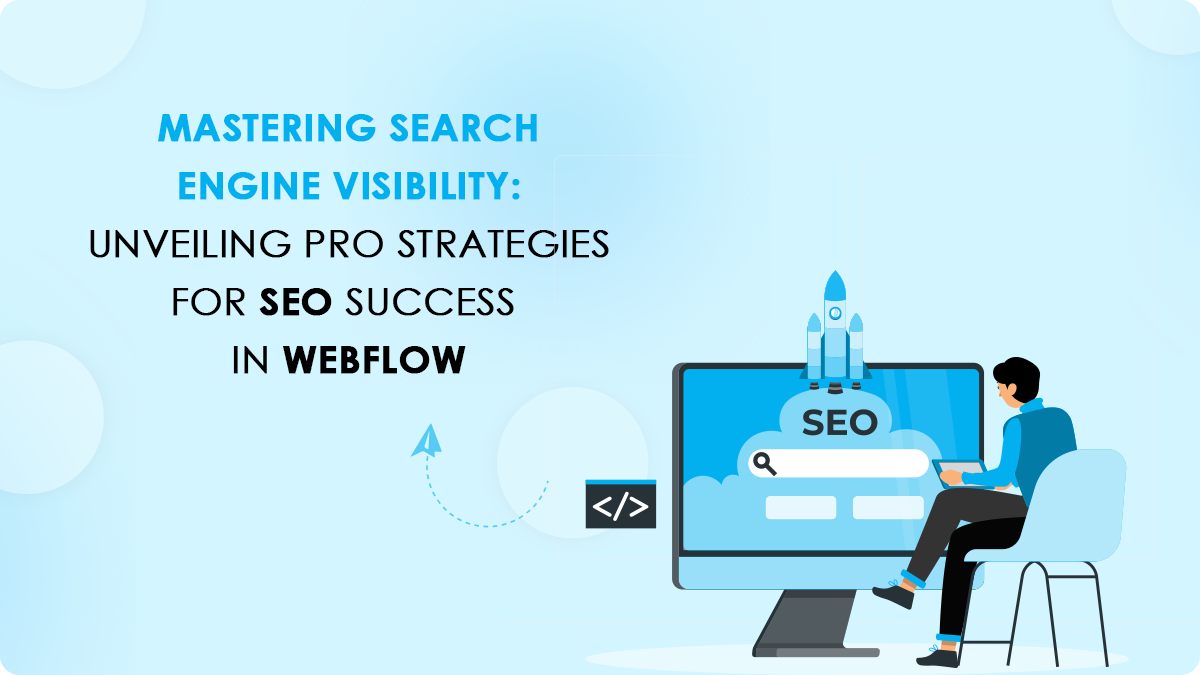The Significance of SEO in Webflow
Search Engine Optimization (SEO) plays a pivotal role in the success of any website, and Webflow is no exception. In today’s digital landscape, where online visibility is crucial for businesses to thrive, mastering the art of SEO can be a game-changer. By optimizing your Webflow website for search engines, you can attract organic traffic, increase brand awareness, and ultimately drive conversions. The significance of SEO lies in its ability to enhance your website’s visibility and accessibility on search engine result pages (SERPs), ensuring that your target audience can easily find you amidst the vast online competition.
Are you tired of your website not getting the visibility it deserves? Are you struggling to attract organic traffic and increase your search engine rankings? Look no further! In this comprehensive article, we will delve into the world of mastering search engine visibility and reveal professional strategies for SEO success in Webflow.
Search Engine Optimization (SEO) is a crucial factor in today’s digital landscape. It determines how easily your website is discovered by search engines like Google, Bing, and Yahoo. Without proper SEO strategies, your web presence might remain hidden among the vast sea of online content.

The Power of Search Engine Visibility
Search engine visibility is the key to unlocking the immense potential of your website in today’s digital landscape. It is the art and science of optimizing your online presence to ensure that search engines like Google, Bing, and Yahoo can easily find, index, and rank your web pages. In this highly competitive online world, where businesses vie for attention and customers’ eyes are constantly searching for solutions, having a strong search engine visibility strategy can be a game-changer.
When your website ranks high in search engine results pages (SERPs), it becomes more accessible to potential customers who are actively searching for products or services like yours. This increased visibility not only drives organic traffic to your site but also establishes trust and credibility among your target audience. By leveraging SEO techniques effectively, you can attract qualified leads, enhance brand recognition, and ultimately increase conversions.
Read more: Writing Code with AI: The Next Frontier in Developer Productivity
Section 1: The Significance of SEO in Webflow
In the vast digital landscape, where countless websites compete for attention, search engine optimization (SEO) plays a pivotal role in enhancing visibility and driving organic traffic. Webflow, a popular website builder known for its flexibility and design capabilities, provides a solid foundation to implement effective SEO strategies.
SEO in Webflow involves optimizing various components of your website to improve its search engine rankings. From keyword research and on-page optimization to technical enhancements and user experience improvements, each aspect contributes to the overall visibility and success of your website. By understanding the role of SEO in Webflow, you can unlock the potential to reach a broader audience, establish credibility, and ultimately achieve long-term online success.

Section 2: Leveraging Web flow’s SEO-Friendly Features
Webflow is designed with SEO in mind, offering a range of features that can boost your website’s visibility. From customizable meta tags to responsive design, we’ll guide you through the SEO-friendly functionalities that Webflow provides and how to make the most of them.
Section 3: Keyword Research and Content Optimization
One of the pillars of SEO success is understanding and implementing effective keyword research. Learn how to identify relevant keywords for your niche and optimize your Webflow site’s content to rank higher on search engine results pages. We’ll also explore the importance of creating valuable, user-centric content.
Section 4: Technical SEO Best Practices in Webflow
Technical SEO plays a crucial role in determining how search engines crawl and index your website. This section will cover technical aspects specific to Webflow, such as optimizing site speed, utilizing clean URLs, and implementing proper redirects. We’ll provide step-by-step guidance to ensure your Webflow site is technically sound for search engines.
Section 5: Building Quality Backlinks
Backlinks remain a powerful ranking factor in search engine algorithms. Discover effective strategies for building quality backlinks to your Webflow site, including outreach, content marketing, and leveraging your existing network. Learn how to ensure that your backlink profile contributes positively to your search engine visibility.
Section 6: Local SEO for Webflow Websites
We’ll explore how Webflow users can optimize their sites for local search, including setting up Google My Business, acquiring local citations, and ensuring consistency in NAP (Name, Address, Phone number) information across the web.
Section 7: Monitoring and Analytics in Webflow
Effective SEO requires continuous monitoring and analysis of your website’s performance. Explore the built-in analytics tools in Webflow and how to integrate third-party analytics platforms. Understand key metrics to track, such as organic traffic, keyword rankings, and user engagement, to make informed decisions and refine your SEO strategy.
Section 8: Staying Updated with SEO Trends
The digital landscape is ever-evolving, and SEO is no exception. Discover how to stay updated with the latest SEO trends and algorithm changes. We’ll provide resources, tools, and tips to ensure that your Webflow site remains optimized and competitive in the dynamic world of search engine visibility.
Read more: User-Centric Design: Meeting the Expectations of Gen Z Audiences
Section 9: Leveraging Social Media for SEO Benefits
Social media has become an integral part of our daily lives, and its impact on search engine optimization (SEO) cannot be overstated. By strategically utilizing social media platforms, businesses can boost their website’s visibility and drive organic traffic. Not only does social media provide an avenue to reach a wider audience, but it also helps in building brand authority and credibility.
When it comes to leveraging social media for SEO benefits, content promotion plays a crucial role. By sharing high-quality content across various social channels, businesses can increase the chances of their content being shared, liked, and linked to. This amplifies the reach of their website and signals to search engines that the content is valuable and worthy of higher rankings. Furthermore, engaging with followers through meaningful interactions on social media creates a sense of community around the brand, fostering trust and loyalty.
Conclusion: Mastering SEO in Webflow
As we conclude, it’s evident that mastering search engine visibility in Webflow requires a multifaceted approach. From leveraging built-in features to implementing advanced strategies like backlink building and local SEO, Webflow users can position their websites for success in search engine rankings. By staying informed, adapting to industry trends, and consistently refining your SEO strategy, you can unlock the full potential of your Webflow site and achieve sustained online visibility. Remember, the journey to SEO mastery is ongoing, and each step taken brings you closer to greater online success.
